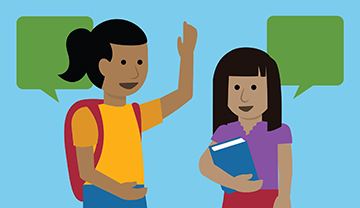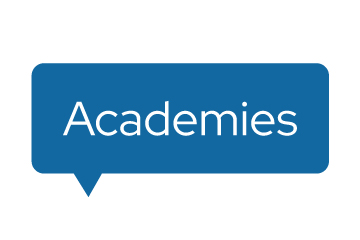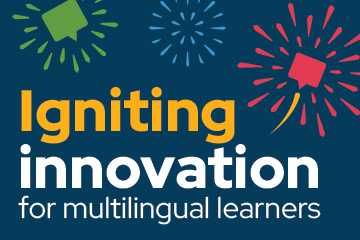Many literacy programs were not designed to effectively use multilingual students’ knowledge, skills, and strengths. This Snapshot is the second in a five-part series that provides insights from relevant research and suggests ways to engage the significant strengths that multilingual learners bring to their literacy development.
Why are oral language skills essential to reading?
Multilingual students’ ability to comprehend spoken words is essential to their development of foundational reading skills. Reading comprehension begins as soon as they learn to understand and use spoken language. These research-based highlights express the importance of balancing explicit skill-based instruction with ample opportunities to strengthen oral language comprehension.
Make time for oral language activities.
 Listening comprehension is foundational to reading comprehension. If students do not comprehend a spoken word, they will likely struggle to comprehend that same printed word, even if they are able to decode it perfectly into sound – reading text is like hearing the words recited in your head.
Listening comprehension is foundational to reading comprehension. If students do not comprehend a spoken word, they will likely struggle to comprehend that same printed word, even if they are able to decode it perfectly into sound – reading text is like hearing the words recited in your head.
- To become readers, students need rich encounters with words in any language, whether spoken or signed (Lee et al., 2020).
- They need to understand many words, connect the sounds of those words to the things they represent, and then learn how those sounds are expressed in print (Seidenberg & Cooper Borkenhagen, 2020).
To strengthen students’ listening comprehension
- Plan for oral interaction throughout the day for students to listen to and share ideas.
- Prioritize speaking and listening activities in any of the languages students use.
- Create inclusive spaces where interaction is encouraged and where multilingual learners have opportunities to speak and listen in pairs or in small groups, as well as in whole-class conversations.
- Lead activities such as interactive read-alouds and storytelling that include purposefully rich vocabulary.
Leverage the power of implicit learning.
Explicit instruction can play a significant role in boosting word knowledge, but “little of the information that supports reading is learned via explicit instruction” (Seidenberg, 2023, p. 2).
The understanding of what words mean, how language is used, and how meanings are constructed and conveyed, develops through extensive, authentic use. In other words, students learn implicitly through meaningful interaction with others in their classrooms, homes and communities.
“Teachers who recognize that explicit instruction is meant to enable children to learn through other experiences can use their limited classroom time more effectively, to their students’ benefit.” Seidenberg, 2023, p. 3
To harness the power of implicit learning
- Make student-led speaking and listening activities part of students’ daily experience in your reading instruction.
- Embed the teaching of new words in context, so that meanings are made clear by activity or experience.
Strengthen reading comprehension through extended conversations about texts.
Multilingual learners’ comprehension of texts should not depend solely on understanding the words within the text. Actual meaning often depends on understanding a network of connected ideas and experiences, and requires students to analyze the text to construct meaning and make connections that may not be apparent on the surface. Teachers can
- Encourage meaning-making through promoting discussion, asking open-ended questions, and encouraging multiple interpretations of a text over single right or wrong answers (Aukerman & Schuldt, 2021).
- Make a concerted effort to ask open-ended questions and foster philosophical discussions (Aukerman & Schuldt, 2021).
- Connect with and celebrate students’ interests, experiences, and goals for reading (Martinez, 2018).
- Instill a sense of agency in multilingual students, who are often relegated to remedial, reductive literacy experiences (Martinez, 2018).
“Listening comprehension…the capacity to understand spoken language…develops through conversation, through hearing and sharing personal stories, and through interactions with rich texts. All of this exposes children to new ideas, new language structures, new vocabulary, and new concepts, until they can access these for themselves by reading increasingly complex texts.” Burkins & Yates, 2021, p. 11
To strengthen comprehension
- Initiate and facilitate extended conversations focused on understanding the texts students are reading.
- Provide opportunities for the open-ended, unscripted conversations that fuel implicit word learning and meaning-making.
References
Aukerman, M., & Chambers Schuldt, L. (2021). What matters most? Toward a robust and socially just science of reading. Reading Research Quarterly, 56, S85-S103.
Burkins, J., & Yates, K. (2021). Shifting the balance: 6 ways to bring the science of reading into the balanced literacy classroom. Stenhouse Publishers.
Lee, C. D., Meltzoff, A. N., & Kuhl, P. K. (2020). The braid of human learning and development: neuro-physiological processes and participation in cultural practices. In Handbook of the cultural foundations of learning (pp. 24-43). Routledge.
Martínez, R. A. (2018). Beyond the English learner label: Recognizing the richness of bi/multilingual students’ linguistic repertoires. The Reading Teacher, 71(5), 515-522.
Seidenberg, M. (2023, December 14). Is the ‘Science of Reading’ becoming too much of a good thing? Education Week. https://www.edweek.org/teaching-learning/opinion-is-the-science-of-reading-becoming-too-much-of-a-good-thing/2023/12
Seidenberg, M. S., & Borkenhagen, M. C. (2020). Reading science and educational practice: Some tenets for teachers. The Reading League Journal, 1(1), 7-11.





